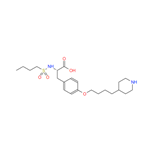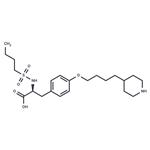
Tirofiban
- Product NameTirofiban
- CAS144494-65-5
- CBNumberCB9169083
- MFC22H36N2O5S
- MW440.6
- EINECS635-682-4
- MDL NumberMFCD05237246
- MOL File144494-65-5.mol
Chemical Properties
| Melting point | 223-225° |
| Boiling point | 611.7±65.0 °C(Predicted) |
| Density | 1.154±0.06 g/cm3(Predicted) |
| storage temp. | Keep in dark place,Sealed in dry,Store in freezer, under -20°C |
| solubility | Limited solubility |
| form | Solid |
| pka | 3.37±0.10(Predicted) |
| color | White to off-white |
| BRN | 6182267 |
| CAS DataBase Reference | 144494-65-5(CAS DataBase Reference) |
| FDA UNII | GGX234SI5H |
| ATC code | B01AC17 |
| UNSPSC Code | 12352106 |
| NACRES | NA.25 |
Safety
| Symbol(GHS) |

|
| Signal word | Warning |
| Hazard statements | H315-H319-H335 |
| Precautionary statements | P261-P264-P271-P280-P302+P352-P305+P351+P338 |
| Hazard Codes | Xi |
| Risk Statements | 36/37/38 |
| Safety Statements | 26 |
| WGK Germany | 3 |
| RTECS | YP2364100 |
| Hazardous Substances Data | 144494-65-5(Hazardous Substances Data) |



